engine oil AUDI A8 2013 User Guide
[x] Cancel search | Manufacturer: AUDI, Model Year: 2013, Model line: A8, Model: AUDI A8 2013Pages: 318, PDF Size: 79.34 MB
Page 209 of 318
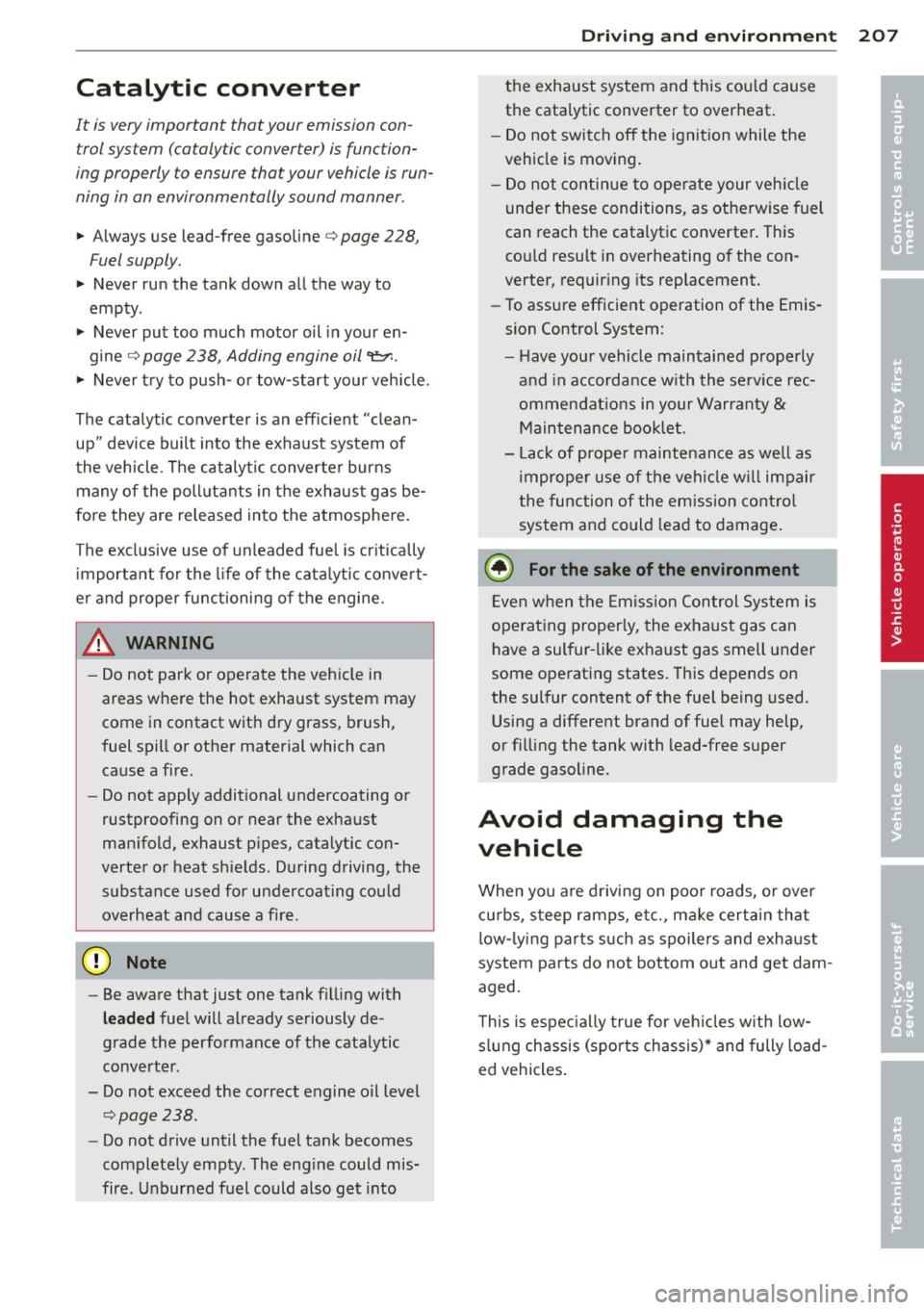
Catalytic converter
It is very important that your emission control system (catalytic converter) is function
ing properly to ensure that your vehicle is run
ning in an environmentally sound manner .
.. Always use lead-free gasoline¢ page 228,
Fuel supply.
.,. Never run the tank down all the way to
empty.
.,. Never put too much motor oil in your en-
gine ¢
page 238, Adding engine oil~-
.,. Never try to push- or tow-start your veh icle.
The catalytic converter is an eff icient "clean
up" device built into the exhaust system of
the vehicle . The catalytic converter burns
many of the pollutants in the exhaust gas be
fore they are released into the atmosphere.
The exclusive use of unleaded fuel is critically
importa nt for the life of the cata lytic convert
e r and proper functioning of the engine.
A WARNING
-
- Do not park or operate the vehicle in
areas where the hot exhaust system may
come in contact with dry grass, brush,
fuel spill or other material which can cause a fire.
- Do not apply additional undercoating or
rustproofing on or near the exhaust
man ifold, exhaust pipes, catalytic con
verter or heat shields. During driving, the
substance used for undercoating cou ld
overheat and cause a fire.
0 Note
- Be aware that just one tank filling with
leaded fuel will already seriously de
grade the performance of the catalytic
converter.
- Do not exceed the correct engine oil level
¢ page 238.
-Do not drive until the fuel tank becomes
completely empty. The eng ine could mis
fire . U nburned fuel could a lso get i nto
Dri vin g and en vironm ent 207
the exhaust system and this cou ld cause
the catalytic converter to overheat .
- Do not swi tch off the ignit ion while the
vehicle is mov ing.
- Do not continue to ope rate your veh icle
unde r these conditions, as othe rwise fuel
can reach the catalytic converter. This
co uld result in overheating o f the con
verter, requir ing its replacement .
- To assure efficient operation of the Emis
sion Control System:
- H ave your vehicle maintained prope rly
and in accordance w ith the se rv ice rec
ommendat ions in you r Warranty &
M aintenance boo klet.
- L ack of prope r maintenance as we ll as
improper use of the vehi cle w il l impair
the function of the em ission contro l
system and could lead to damage .
@ For the sake of the environment
Even when the Emiss ion Control System is
operat ing properly, the exha ust gas can
have a sul fur -li ke exhaust gas smell under
some operating states . This depends on
the sulfur content of the fuel being used .
Using a different brand of fue l may help,
or filling the tank with lead-free super
grade gasoline .
Avoid damaging the
vehicle
When you are drivi ng on poo r roads, or over
c ur bs, s teep ramps, etc., ma ke certai n that
low -lying parts s uch as spoilers and exhaust
system pa rts do not bottom o ut and get dam
aged.
T h is is espec ially true for veh icles w ith low
s lung chassis (spor ts chassis)* and fully load
ed vehicles. •
•
Page 211 of 318

Avoid full throttle
Driving at moderate speeds saves fuel and
improves your mileage.
11-Try and keep well below your car's maxi-
mum speed.
Accelerating gently reduces fuel consump tion, engine wear, and does not disturb the
environment.
F ue l consumption, exhaust emissions and en
g ine noise increase disproportionately at high
speeds. If you drive at approximately three
quarters of top speed, fuel consumption will
be reduced by one half. Never drive faster
than the posted speed limit and weather con
d itions permit .
Reducing unnecessary idling
Even when your car is just idling it burns up
fuel.
11-Shut the engine off when you are not driv
ing the vehicle.
"" Do not warm up the veh icle by letting the
engine run at idle .
The idling phase is automat ically reduced for
vehicles w ith the Start/Stop system . It is effi
cient to switch
off the engine in vehicles with
out the Start-Stop-System when stopped at ra il road crossings and long red lights. Turning
the eng ine
off for just 30 -40 seconds saves
mo re fuel than is burned by s tarting the en
gine again.
It takes a long time fo r the engine to wa rm up
fu lly when it is running at idle. Howeve r, wear
and noxious emissions are especially high
when the engine is warming up. So you should
drive away as soon as you start the engine and
avoid running at h igh rpms while the engine is
still warming up.
CD Note
Do not leave engine idling unattended af
ter starting. If warning lights shou ld come
on to indicate improper operation, they
Dri vin g and en vironm ent 209
would go unheeded. Extended idling a lso
produces heat, which could result in over
heating or other damage to the veh icle or
other property.
Regular maintenance
A badly tuned engine unnecessarily wastes a lot of fuel.
11-Have your vehicle serviced at reg ular inter-
vals .
By having your ve hicle reg ularly se rviced by an
Audi dealer he lps to ensure that it runs prop
erly and economically . The condition of your
vehicle not only affects its safety and ability to
ho ld its va lue, it also affects
fuel co nsump
tion .
Chec k your oil e ach t ime you fill y our t ank.
T he amou nt of o il used is re lated to engine
load and speed.
It is normal for the oil consumption of a new
engine to reac h its lowest value after a certa in
mileage has bee n driven.
You must drive your veh icle about 3,000 m iles
(5,000 kilometers) before you can properly
assess oil consumpt ion.
This also applies to fuel consumption and en gine output .
CD Note
-Have your veh icle ma inta ined properly
and in accordance with the service rec
ommendations in your Warranty
& Ma in
tenance book let . Lack of proper mainte
nance as well as improper use of the ve
hicle will impai r the function of the
em ission cont ro l system and cou ld lead
t o damage.
- Do not alter or remove any component of
t he Emission Control System unless ap
proved by the manufacture r.
- Do not alter or remove any devi ce, such
as heat shie lds, switches, ign ition w ires,
valves, which are designed to protect
your vehicle's Emission Control System
•
•
Page 218 of 318
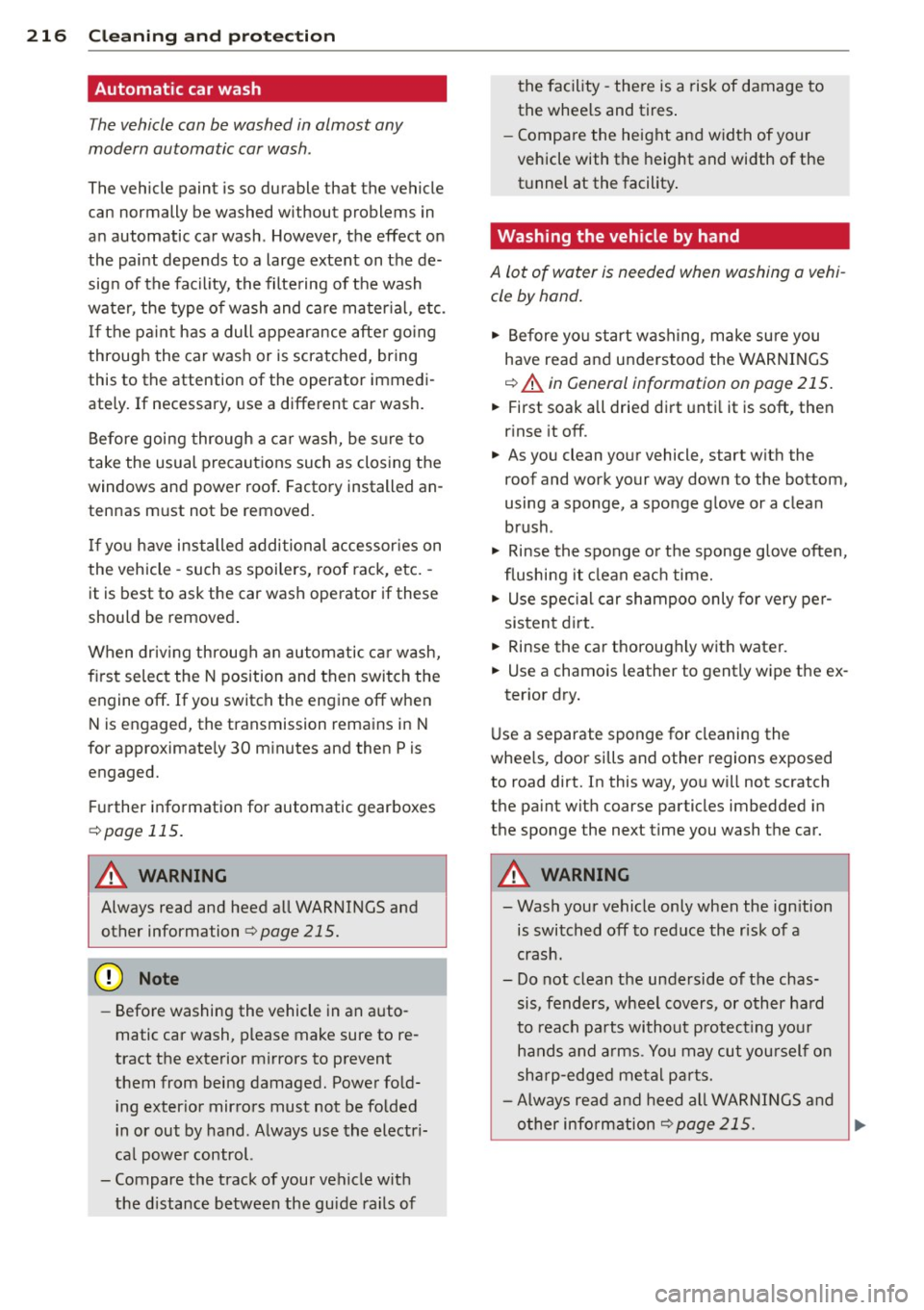
216 Cleaning and protec tio n
Automatic car wash
The vehicle can be washed in almost any
modern automatic car wash .
The vehicle paint is so durable that the vehicle
can normally be washed without problems in
an automatic car wash. However, the effect on
the paint depends to a large extent on the de
sign of the facility, the filte ring of the wash
water, the type of wash and care mater ial , etc.
I f the pa int has a dull appearance afte r going
through the car wash or is scratched, bring
this to the attention of the operator immedi
ately. If necessary, use a different car wash.
Before going through a car wash, be sure to
take the usual precautions such as closing the
windows and power roof . Factory installed an
tennas must not be removed.
I f you have installed additional accessor ies on
the vehicle - such as spoilers, roof rack, etc. -
it is best to ask the car wash operator if these
should be removed .
When driving through an automatic car wash,
fi rst se lect the N position and then switch the
engine off. If you switch the engine off when N is engaged, the transmission remains in N
for approximately 30 m inutes and then Pis
engaged.
Further information for automatic gearboxes
~ page 115.
A WARNING
Always read and heed all WARNINGS and
other information
r:::;, page 215.
- Before washing the vehicle in an auto
matic car wash, p lease make sure to re
tract the exterior mirrors to prevent
them from being damaged. Power fold i ng exter ior mirrors must not be folded
i n or out by hand . Always use the electri
ca l power control.
- Compare the track of your vehicle with the d istance between the guide rails of the facility - the
re is a risk of damage to
the whee ls and tires .
- Compare the height and width of your
vehicle with the height and width of the tunnel at the facility .
Washing the vehicle by hand
A lot of water is needed when washing a vehi
cle by hand.
.,. Before yo u start washing, make su re you
have read and understood the WARNINGS
~ A in General information on page 215.
.,. First soak all dried dirt unti l it is soft, then
rinse it off.
.,. As you clean your vehicle, start with the
roof and work your way down to the bottom,
using a sponge, a sponge glove or a clean brush .
.,. Rinse the sponge o r the sponge g love often,
flushing it clean each time.
.,. Use spec ial car shampoo only for very per
sistent dirt .
.,. Rinse the car thoroughly with water.
.,. Use a chamois leather to gently wipe the ex-
ter ior dry.
Use a separate sponge for cleaning the
whee ls , door si lls and other regions exposed
to road dirt. In this way, you will not scratch
the pa int with coarse particles imbedded in
the sponge the next time you wash the car.
A WARNING
-- Wash your vehicle only when the ign ition
is switched off to reduce the risk of a
crash.
- Do not clean the underside of the chas sis, fenders, wheel covers, or other hard
to reach parts without protect ing your
hands and arms . You may cut you rself on
sha rp-edged metal pa rts.
- Always read and heed all WARNINGS and other info rmation
c;, page 215. ~
Page 235 of 318

-Always disconnect the battery.
- Never smoke or work near heaters or open flames. Fluids in the engine com
partment could start a fire.
- Keep an approved fire extinguisher im
mediately available.
- To avoid electrical shock and personal in
jury while the engine is running or being
started, never touch :
- Ignition cables
- Other components of the high voltage
electronic ignition system.
- If you must perform a check or repair
with the engine running:
- First, fully apply the parking brake,
move selector lever to "P" (Park).
- Always use extreme caution to prevent
clothing, jewelry, or long hair from get
ting caught in the radiator fan, V-belts
or other moving parts, or from contact ing hot parts. Tie back hair before
starting, and do not wear clothing that
will hang or droop into the engine.
- Minimize exposure to emission and
chemical ha zards c:::> & .
A WARNING
California Proposition 65 Warning:
- Engine exhaust, some of its constituents,
and certain vehicle components contain
or emit chemicals known to the State of
California to cause cancer and birth de
fects and reproductive harm. In addition ,
certain fluids contained in vehicles and
certain products of component wear con
tain or emit chemicals known to the
State of California to cause cancer and
birth defects or other reproductive harm .
Checking and filling 233
-Battery posts, terminals and related ac
cessories contain lead and lead com
pounds, chemicals known to the State of
California to cause cancer and reproduc
tive harms. Wash hands after handling.
(D Note
When adding fluids, always make sure that
they are poured into the proper container
or filler opening, otherwise serious dam
age to vehicle systems will occur.
(® For the sake of the environment
To detect leaks in time, inspect the vehicle
floor pan from underneath regularly . If
you see spots from oil or other vehicle flu ids, have your vehicle inspected by an au
thorized Audi dealer.
Closing the engine hood
.,. Pull the hood down until the pressure from
the struts is reduced.
"' Let the hood
drop down and latch in place.
Do not try to push it shut; it may fail to en
gage
c:::> ,A .
A WARNING
-
A hood that is not completely latched
could fly up and block your view while driv
ing .
- When you close the engine hood, check it
to make sure the safety catch has proper ly engaged. The hood should be flush
with the surrounding vehicle body parts.
- If you notice while driving that the hood
is not secured properly , stop at once and
close it. •
•
Page 237 of 318
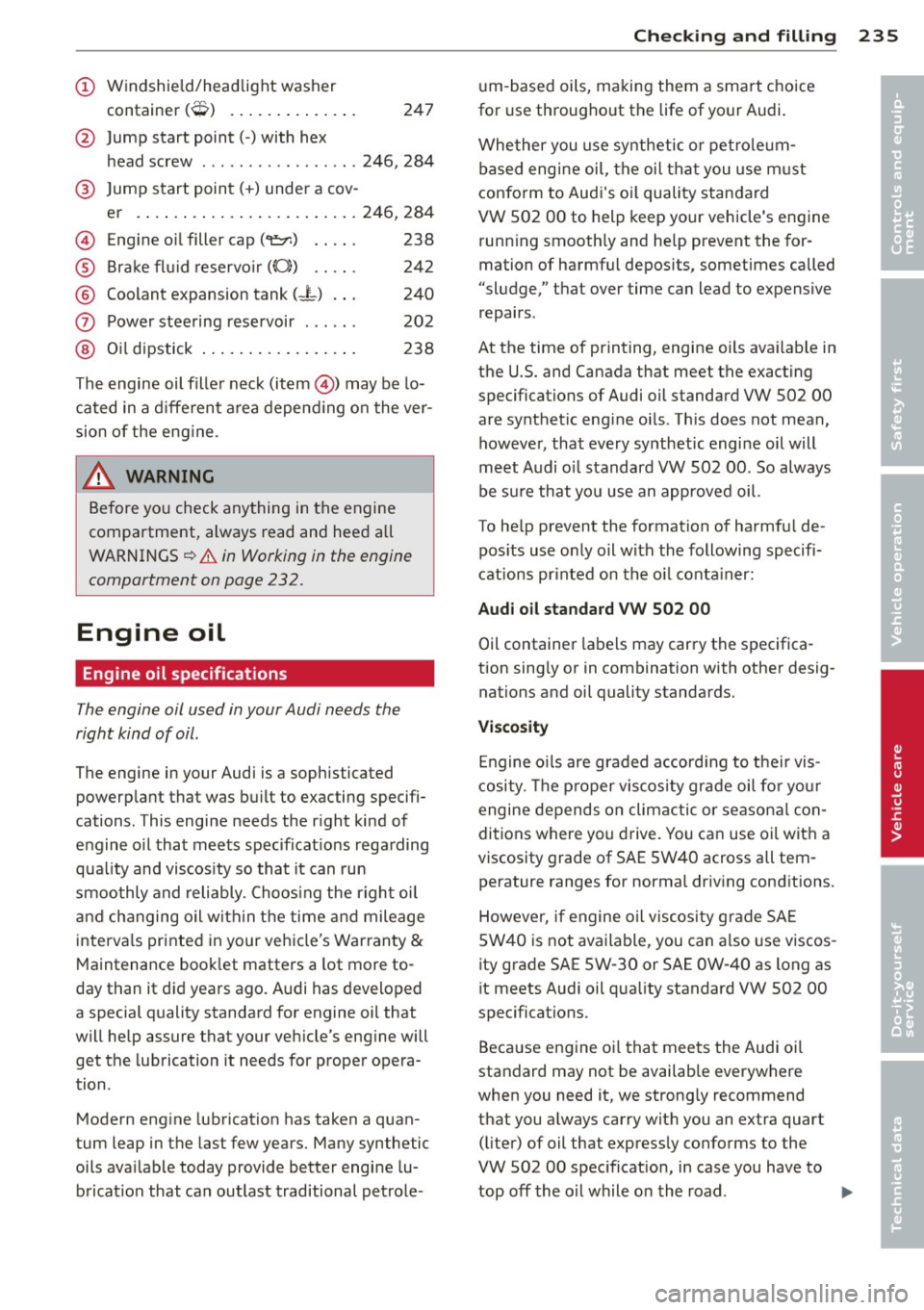
(!) Windshield/headlight washer
t .
(~ ) con ainer ,..., .. .... ... ... . . 247
@ Jump start point( -) with hex
h ead screw ............... .. 246, 284
® Jump start point( +) under a cov-
er . ..... .. ... .. ..... ... .. . 246, 284
@ Engine oil filler cap(~) . . . . . 238
® Brake fl uid reservo ir ((0)) . . . . . 242
® Coolant expansion tank (-L) . . . 240
0 Power steering reservoir . . . . . . 202
@ Oil dipstick . . . . . . . . . . . . . . . . . 238
The engine oil fille r nec k (item @) may be lo
cated in a d ifferent a rea depend ing o n the ver
sion of the eng ine .
A WARNING
Before yo u check any thing in the engine
compartment, always read and heed all
WARNINGS
~ &. in Working in the engine
compartment on page 232.
Engine oil
Engine oil specifications
The engine oil used in your Audi needs the
right kind of oil.
-
The engine in your Audi is a sophisticated
powerp lant that was bu ilt to exacting specifi
cations. This engine needs the r ight kind of
engine o il that meets specificat ions rega rding
qua lity and viscos ity so that it can run
smoothly and reliably . Choos ing the righ t oi l
and ch anging oil with in t he time and mileage
inte rva ls printed in your veh icle's Warranty
&
M aintenance book let matters a lot more to
day than it d id years ago. A udi has developed
a special quality standard for engine oil that
will he lp assure that your veh icle's eng ine will
get the lubrication it needs for prope r opera
tion .
M odern eng ine lubrication has taken a quan
tum leap in the last few years. Many synthetic
oils ava ilable today provide better engine lu
brication that can outlast traditional pet role -
Checkin g and fillin g 235
um -based oils, ma king them a smart cho ice
for use throughout the life of your Audi.
Whether you use sy nthetic o r pe trole um
based eng ine oil, the oil tha t you use m ust
confo rm to Aud i's oi l quality standard
VW 502 00 to help keep your vehicle's engine runn ing smooth ly and he lp prevent the for
mation of harmful deposits, sometimes called
"sludge," that over time can lead to expensive
repairs .
At the time of printing, engine oils ava ilab le in
the U.S. and Canada that meet the exact ing
specifications of Audi oi l standard VW 502 00
are synthet ic eng ine o ils . Th is does not mean,
howeve r, that every sy nthetic engi ne oil will
meet A udi o il standard VW 502 00 . So always
be s ure that yo u use an approved oil.
To he lp prevent the formation of harmfu l de
pos its use on ly o il wi th the following specifi
cat ions pr inted on th e oil conta iner:
Audi oil standard VW 502 00
Oil container labe ls may car ry the specifica
tion sing ly or in combination with othe r desig
nations and oil quality standards.
Viscosity
E ngine o ils are graded a ccord ing to the ir vis
cosi ty . T he p roper viscos ity grade oil fo r yo ur
engine depends on climactic o r seasona l con
ditions where yo u drive. You can use oi l wit h a
viscosity grade of SAE 5W40 across all tem
perature ranges for norma l driv ing cond itions.
However, if engine oil viscosity g rade SA E
5W40 is not available, you can also use viscos
ity grade SAE 5W -30 or SAE OW -40 as long as
it meets Audi oil q ua lity standard VW 502 00
specifications.
Because eng ine o il tha t meets the Audi oi l
standard may not be availab le everywhere
when you need it, we strong ly recommend
that you a lways carry wit h you an extra quart
( li ter) of oil that express ly conforms to the
VW 502 00 spec if icat ion, in case you have to
top off the o il while o n the road . .,..
•
•
Page 238 of 318
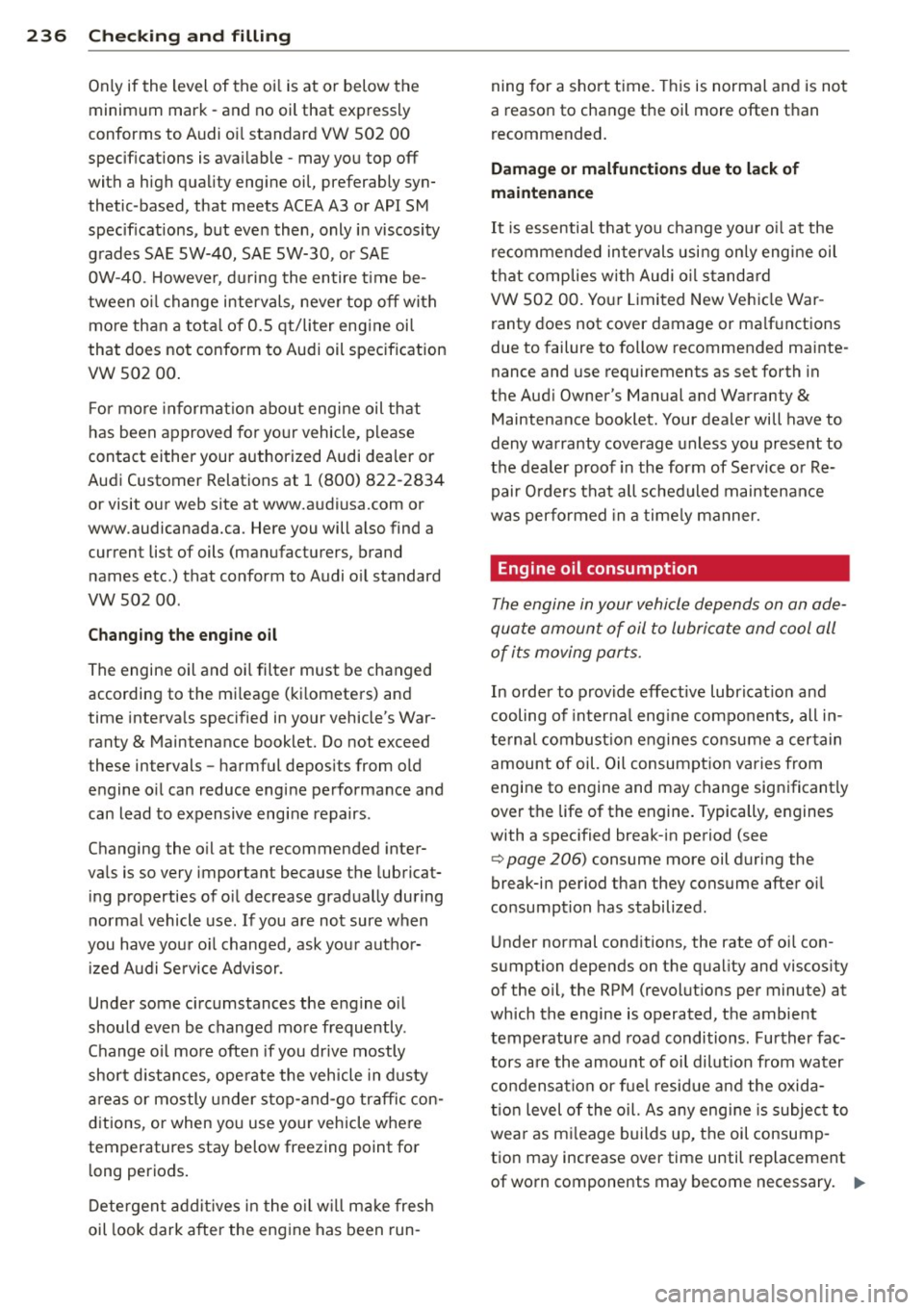
236 Check ing and filling
Only if the level of the oi l is at or below the
minimum mark -and no oil that expressly
conforms to Audi o il standard VW 502 00
specifications is ava ilable - may you top off
with a high quality eng ine oil, preferably syn
thetic -based, that meets AC EA A3 or API SM
specif ications, but even then, only in viscos ity
grad es SAE SW-40, SA E SW-30 , or SAE
OW-40. Howeve r, during the en tire t ime be
tween oi l change intervals, never top off with
more than a tota l of 0.5 qt/liter eng ine oi l
that does not conform to Audi oil specification
vw 502 00 .
F or more informa tion about engine oil that
has been approved for yo ur vehicle , please
contact either your authorized Audi dealer or
Audi Customer Relations at 1 (800) 822-2834
or visit our web site at www.audiusa.com or
www.audicanada.ca . Here you will a lso find a
current list o f oils (manufacturers, brand
names etc .) that conform to Audi o il standard
vw 502 00.
Chang ing the engine oil
The engine oil and oi l filter must be changed
according to the m ileage (ki lometers) and
time interva ls specified in your vehicle's War
ranty
& Maintenance booklet. Do not exceed
these in tervals -harmful depos it s from old
engine o il can reduce engine performance and
can lead to expensive eng ine repairs .
Changing the o il at the recommended inter
va ls is so very important because the lubricat
ing p roperties of o il decrease gradually during
norma l vehicle use. If you are not sure when
you have you r o il changed, ask you r autho r
iz ed Audi Service Advisor.
Under some c ircumstances the engine o il
should even be changed more frequently .
Change oi l mo re often if you drive mostly
short d istances , ope rate the vehicle in dusty
a reas or mostly under s top-and-go tr affic con
d itions , or when yo u use your vehicle whe re
temperatures stay below freezing point for l ong periods .
D etergen t add itives in the o il w ill mak e fresh
oil look dark after the eng ine has been run- ning for a sho
rt time. This is normal and is not
a reason to change the oil more often than
recommended.
Damage or malfunctions due to l ack of
maintenance
It is essentia l th at you c hange yo ur oil at the
r ecommended intervals usi ng on ly eng ine oil
that comp lies with Audi oi l standa rd
VW 502 00. You r Limited New Vehicle War
r anty does not cover damage or ma lf u nctions
due to failure to follow recommended ma inte
nance and use requirements as set forth in
the Aud i Owner's Manual and Warranty
&
Maintenance booklet. Your dealer will have to
deny warranty coverage unless you present to
the dealer proof in the form of Service o r Re
pair Orders that all scheduled maintenan ce
w as performed in a time ly m anner.
Engine oil consumption
The engine in your vehicle depends on an ade
quate amount of oil to lubri cate and
cool all
of its moving por ts .
In order to p rovide effective lubricat ion and
c ooling of inte rna l eng ine compo nents, all i n
tern al combust ion engines co nsume a cer tain
amount of oil. Oil consumpt ion varies from
engine to engine and may change significantly
over the life of the engine . Typically , engines
with a spec ified break-in period (see
¢ page 206) consume more oil duri ng the
break-i n period than they consume after o il
consumption has stabilized .
Under normal cond itions , the rate of oi l con
s u mption depends on the q uality and viscos ity
of the oil, the RPM (revolut ions per minu te) at
which the engine is operated, the ambient
temperature and road conditions. Further fac
tors a re the amount of oil dilut ion from water
c o ndensa tion or fue l resid ue a nd the oxida -
t ion level of the oil. As any engine is subjec t to
wea r as m ileage b uilds up, the oil consump-
tion may increase over time until replacement of wo rn components may become necessary. ..,..
Page 239 of 318
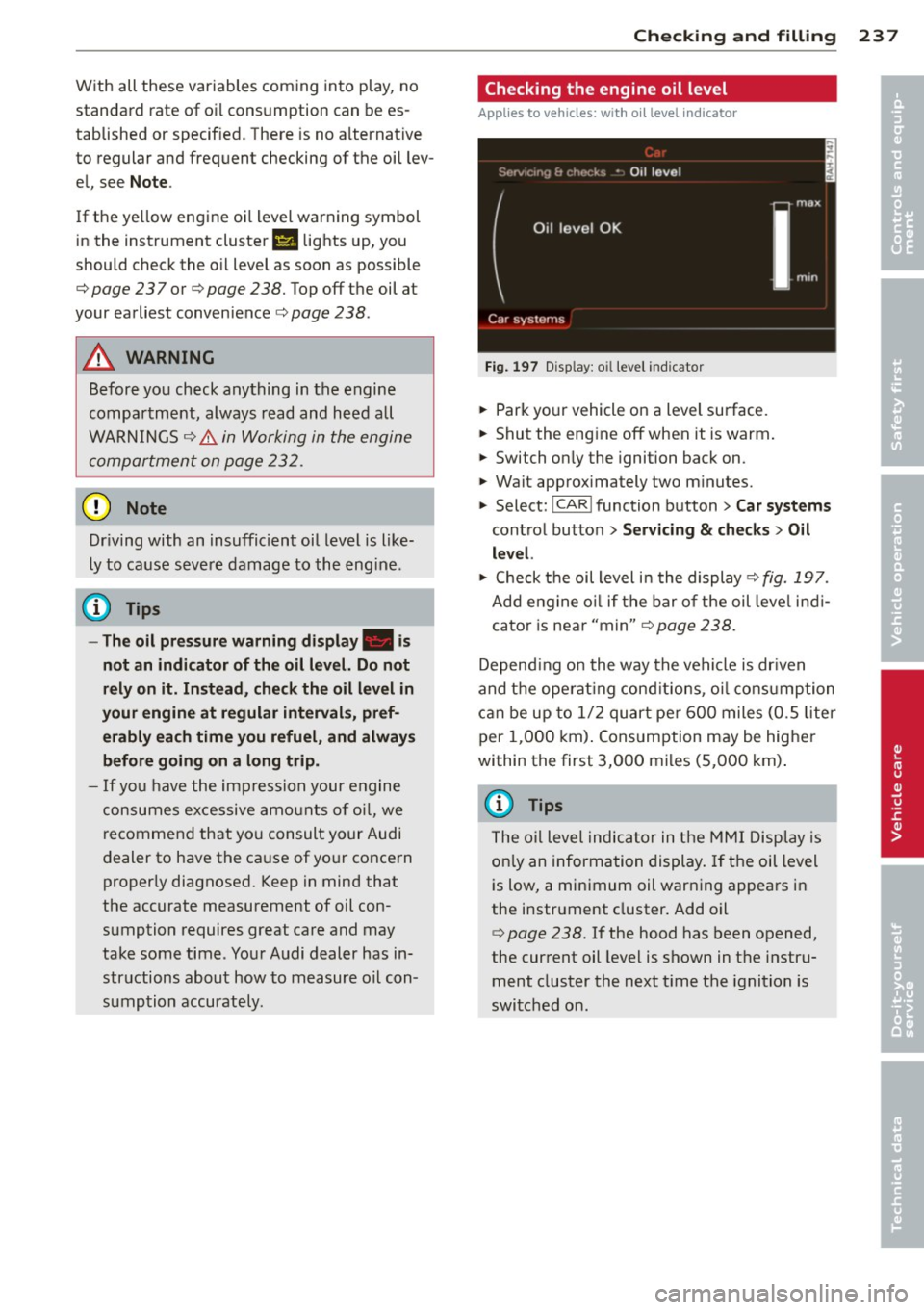
With all these variables coming into play, no
standard rate of oil consumption can be es
tablished or specified . There is no alternative
to regular and freq uent checking of the oi l lev
e l, see
Note .
If the ye llow engine oi l level war ning symbol
in the instrument cluster
II lights up, you
should check the o il level as soon as possible
¢
page 23 7 or ¢ page 238. Top off the oil at
your earliest convenience¢
page 238 .
.&_ WARNING
Before yo u check anything in the engine
compartment, always read and heed all
WARN INGS
¢ &. in Working in the engine
compartment on page 232.
0 Note
Dr iving with an insufficient oil level is like
ly to ca use seve re damage to the eng ine.
{1) Tips
- The oil pressu re warning display. i s
not an indicator of the oi l level. Do not
rely on it. Instead , check th e oil level in
your engine at regular interval s, pref
erably each time you refuel, and always before going on a long trip .
-If yo u have the impres sion your engine
consumes excessive amo unts o f oil, we
r ecommend that yo u consult your Audi
dealer to have the ca use of yo ur conce rn
proper ly diagnosed . Keep in mind that
the accurate measurement of oil con
sumption requires great care and may
take some time. You r Audi dealer has in
str uctions about how to measure o il con
sumption accurately.
Checkin g and fillin g 237
Checking the engine oil level
Applies to vehicles : wit h oil level indicator
Fi g. 1 97 Disp lay: o il leve l indicator
.,. Park yo ur vehicle on a level surface.
.,. Shut the eng ine off when it is warm .
.,. Switch on ly the ignition back on .
.,. Wait approx imately two m inutes.
.,. Select:
I CAR ! function button > Car systems
contro l butto n > Servicing & checks > Oil
level.
.,. Check t he oil level i n the display ¢ fig. 197.
Add eng ine o il if t he bar o f the oil leve l ind i
cator is near "min"¢
page 238.
Depend ing on the way the vehicle is dr iven
and t he ope rat ing cond it ions, oi l cons umption
c a n be up to 1/ 2 quart pe r 60 0 miles (0.S liter
per 1,000 km) . Cons umption may be higher
within the first 3,000 m iles (S,000 km) .
(D Tips
The o il leve l indic ato r in the MMI Disp lay is
on ly an informa tion display.
If t h e oil level
i s low, a minimum oil warn ing appears in
the instrument cluster. Add oil
¢
page 238. If the hood has been opened,
the current oil level is shown in t he instr u
ment cluster the next t ime the ignition is
swi tched on.
•
•
Page 240 of 318
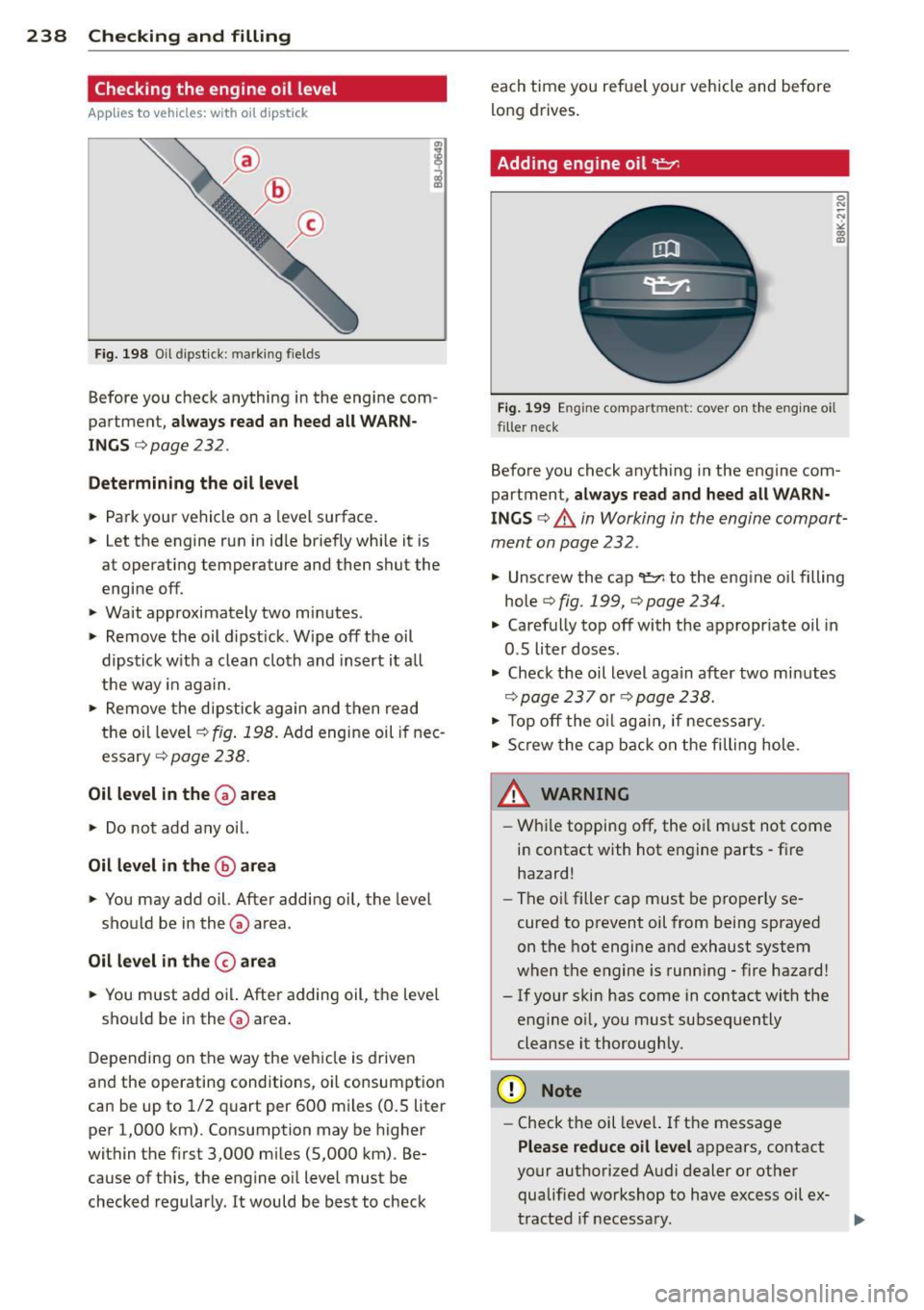
238 Checking and filling
Checking the engine oil level
App lies to vehicles: with oi l dipst ick
Fig. 198 Oil dipsti ck: marking fields
Before you check anything in the engine com
partment,
always read an heed all WARN
INGS c::;,page 232.
Determining the oil le vel
.. Park your vehicle on a leve l surface .
.. Let the engine run in id le b riefly while it is
at operating temperature and then shut the
engi ne off.
.. Wait approximately two min utes .
.. Remove the oil d ipst ick . W ipe off the oil
dip stic k w it h a clean cloth a nd insert i t all
t h e way in aga in .
.. Remove the dipstick again and t hen read
t h e oi l level
¢ fig . 198. Add engine oil if nec
essary
¢ page 238.
Oil level in the~ area
.. Do not a dd any oi l.
Oil level in the @area
.. You may add oil. After adding oil, the level
shou ld be i n the
G) area.
Oil level in the 0 area
.. You must add o il. Afte r adding oil, t he leve l
sho uld be in the
G) area .
D epending on the way the vehicle is drive n
a nd the operating conditions, oil consumpt ion
can be up to 1/2 q uart per 600 mi les (0.5 liter
per 1 ,000 km) . Cons umption may be higher
wit hin the f irst 3,000 mi les (5,000 km) . Be
cause of th is, t he engine o il level must be
checked regularly . It would be best to check each time you ref
ue l your vehicle and before
lo ng d rives .
Adding engine oil~
0 N ,.
"' 0:, m
Fig. 199 En g in e co mpa rtm ent : cove r on th e eng in e o il
f il le r neck
Befo re you check anyth ing in the engine com
partment,
always read and heed all WARN
INGS c::;, A in Working in the engine compart
ment on page 232 .
.. Unscrew the cap "l!:ir. to the eng ine oi l filling
hole
c::;, fig . 199, c::;, page 234 .
.. Carefully top off with t he appropr iate oil in
0 .5 li ter doses.
.. Check the oil level again after two minut es
c::;, page 237 or ¢ page 238 .
.. Top off the o il agai n, if neces sary.
.. Scr ew the ca p ba ck on the fi lling hole.
A WARNING
- W hil e to ppin g off, the o il m ust not co me
i n contact with hot en gine parts -fir e
hazard!
- Th e o il filler cap must be pr ope rl y se
cured to p revent oil from being sprayed
on the hot engi ne and e xhaust system
when t he engine is runn ing -fire haza rd !
- If you r skin has come in contact wit h the
e ng ine o il, you must subseq uently
cleanse it thor oughly.
(D Note
- Check the oil leve l. If the message
Please reduce oil level appears, contact
yo ur authorized A ud i d ealer or othe r
qualified worksh op to have excess oil ex-
t ract ed if necessa ry. .,,_
Page 241 of 318
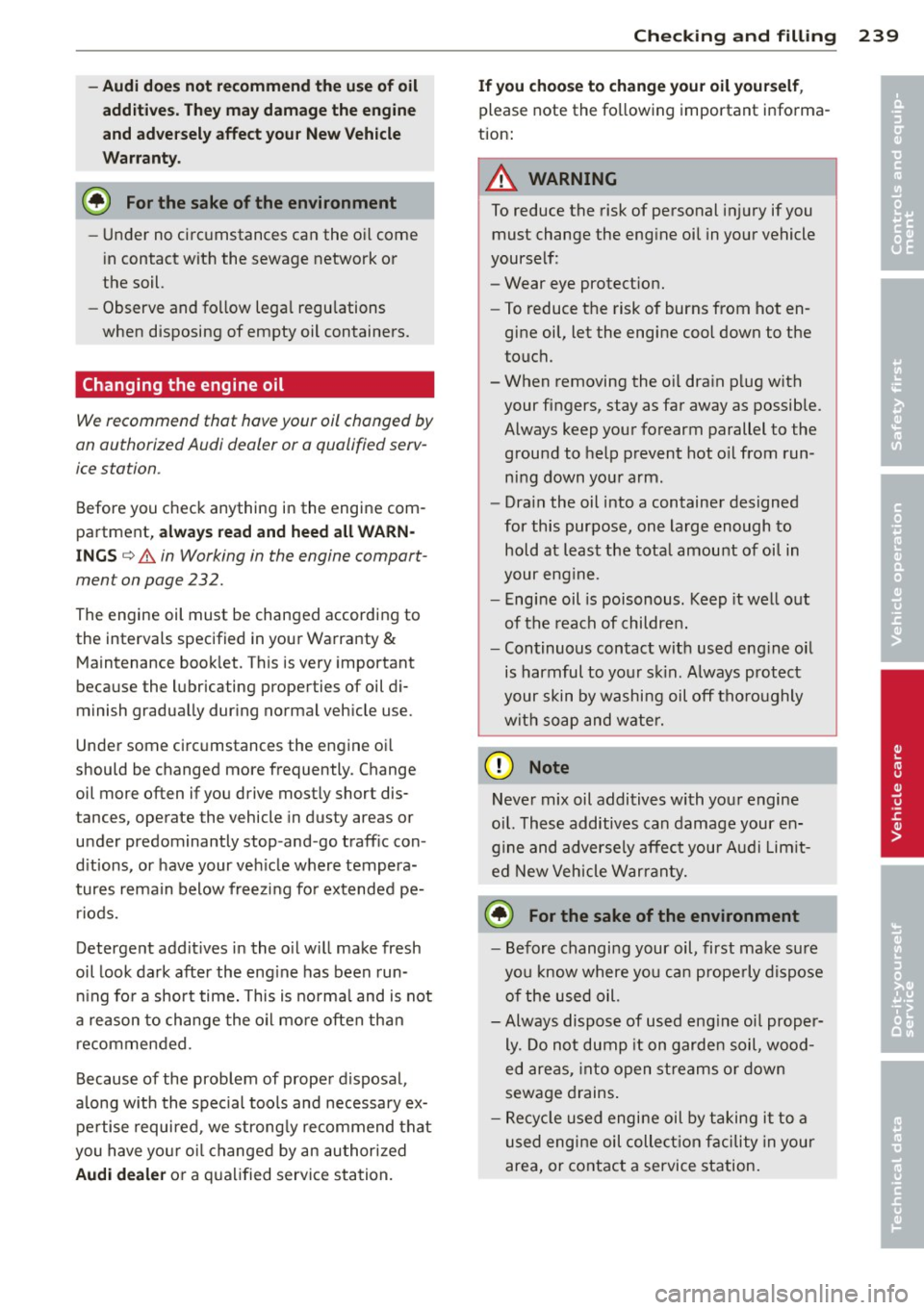
-Audi doe s not recommend the use of oil
add iti ve s. T he y ma y damage the engine
and ad ve rse ly affect you r New Vehicle
Wa rrant y.
@ For the sake of the environment
- Under no circumstances can the oil come
in contact with the sewage network or
the soil.
- Observe and follow lega l regu lations
when disposing of empty oil containers.
Changing the engine oil
We recommend that hove your oil changed by
on authorized Audi dealer or a qualified serv
ice station .
Before you check anything in the engine com
partment,
a lw ays r ead and heed all WARN
ING S
c:> &. in Working in the engine comport
ment on page 232.
The engine oil must be changed according to
the intervals specified in your Warranty
&
Maintenance booklet. This is very important
because the lubricating properties of oil di
minish gradually dur ing normal veh icle use.
Under some circumstances the engine oil
should be changed more frequently. Change
oil more often if you drive mostly short dis
tances, operate the vehicle in dusty areas or
under predominantly stop-and -go traff ic con
d itions, or have your veh icle where tempera
tures remain below freezing fo r extended pe
r iods.
Detergent additives in the o il w ill make fresh
oil look dark after the eng ine has been run
n ing fo r a short time. This is norma l and is not
a reason to change the oi l mo re often than
recommended.
Because of the problem of proper disposal,
along w ith the special tools and necessary ex
pe rtise required, we strong ly recommend that
you have your oi l changed by an author ized
A udi dealer or a qualified service station.
Checkin g and fillin g 239
If yo u choose to change you r oil yo urs elf ,
please note the fo llowing important informa
tion:
_& WARNING
To reduce the risk of personal injury if you
must change the engine oil in your vehicle
yourself:
- Wear eye protect ion.
- To reduce the risk of burns from hot en-
gine oil, let the engine cool down to the
touch.
- When removing the oi l dra in p lug with
your fingers, stay as far away as possible.
Always keep your forearm parallel to the
grou nd to help prevent hot o il from run
ning down you r arm.
- Dra in the oil into a container designed
for this purpose, one large enough to hold at least the tota l amount of oil in
your engine.
- Engine oil is poisonous. Keep it well o ut
of the reach of children.
- Continuous contact with used eng ine o il
is harmful to yo ur skin . A lways protect
your skin by washing oil off tho roughly
w it h soap and w ater.
d) Note
N eve r mix oil additives with your engine
oil. These additives can damage your en
g ine and adversely affect your Audi Lim it
ed New Vehicle Warranty.
@ For the sake of the environment
- Before changi ng your oil, first make sure
you know where you ca n prope rly dispose
of the used oil.
- Always dispose of used eng ine oi l proper
ly. Do not dump it on garde n soil, wood
ed areas, into open streams or down
sewage drains .
- Recycle u sed engi ne oil by taking it to a
used eng ine oil colle ct ion facility in your
area, or contact a service station.
•
•
Page 242 of 318
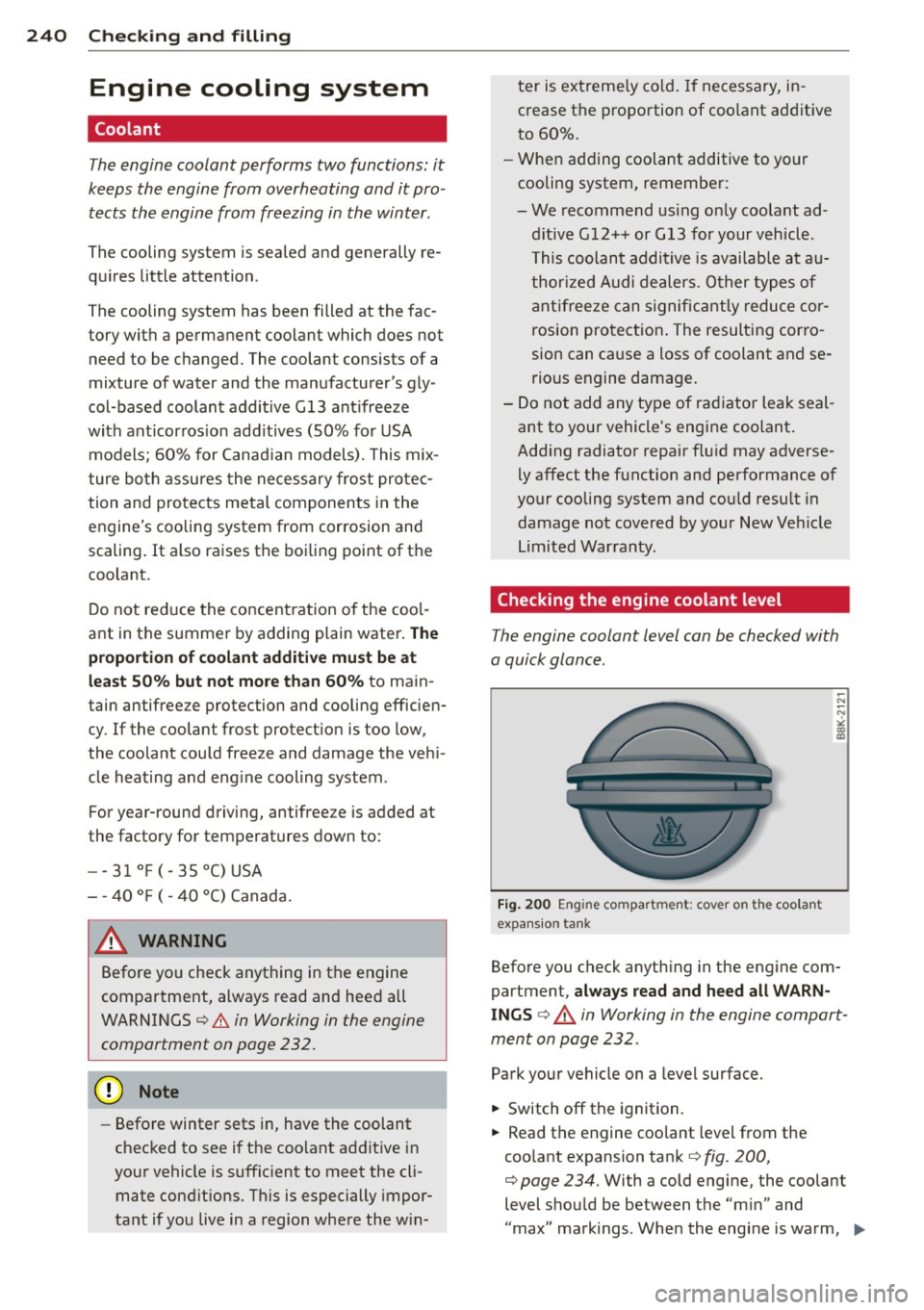
240 Checking and filling
Engine cooling system
Coolant
The engine coolant performs two functions: it
keeps the engine from overheating and it pro
tects the engine from freezing in the winter .
The cooling system is sealed and generally re
quires little attention.
The cooling system has been filled at the fac
tory with a permanent coolant which does not need to be changed. The coolant consists of a
mixture of water and the manufacturer's gly
col-based coolant additive Gl3 ant ifreeze
with anticorros ion add itives (50% for USA
models; 60% for Canadian models). This mix
ture both assures the necessary frost protec
tion and protects metal components in the
engine's cooling system from corrosion and
scaling. It also raises the boiling point of the
coolant.
Do not reduce the concentration of the coo l
ant in the summer by adding plain water .
The
proportion of coolant additive must be at
least 50% but not more than 60%
to main
tain antifree ze protection and cooling efficien
cy. If the coolant frost protection is too low,
the coolant could freeze and damage the veh i
cle heating and engine cooling system .
For year-round driving, antifree ze is added at
the factory for temperatures down to:
- -31°F(-35°C)USA
- - 40 °F ( - 40 °C) Canada.
A WARNING
Before you check anything in the engine
compartment, always read and heed all
WARNINGS
c:> &. in Working in the engine
compartment on page 232.
- Before winter sets in, have the coolant
checked to see if the coolant additive in
your vehicle is sufficient to meet the cli
mate conditions. This is especially impor
tant if you live in a region where the w in- ter
is extreme ly cold . If necessary, in
crease the proportion of coolant additive
to 60%.
- When adding coolant additive to your
cooling system, remember:
- We recommend using only coolant ad
ditive Gl2++ or Gl3 for your vehicle .
This coolant additive is available at au
thorized Audi dealers. Other types of
antifreeze can significantly reduce cor
rosion protection. The resulting corro
sion can ca use a loss of coolant and se
rious engine damage.
- Do not add any type of radiator leak seal
ant to your vehicle's engine coolant .
Add ing radiator repair fluid may adverse
ly affect the function and performance of
your cooling system and could result in
damage not covered by your New Vehicle
Limited Warranty.
Checking the engine coolant level
The engine coolant level can be checked with
a quick glance .
Fig. 200 Engin e compar tmen t: cover on t he coolant
expansio n ta nk
Before you check anything in the engine com
partment,
always read and heed all WARN
INGS c:> &. in Working in the engine compart
ment on page 232 .
Park your vehicle on a level surface .
.,. Switch off the ignition.
.,. Read the engine coolant level from the
coo lant expansion tank
c:> fig. 200,
c:> page 234. With a cold engine, the coolant
level should be between the "min" and
"max" markings. When the engine is warm, ..,